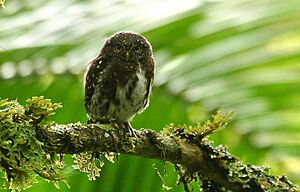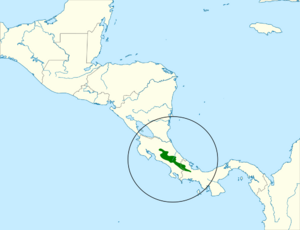Costa Rican pygmy owl facts for kids
Quick facts for kids Costa Rican pygmy owl |
|
|---|---|
 |
|
| Savegre Lodge, near San Gerardo, Costa Rica | |
| Conservation status | |
| Scientific classification | |
| Genus: |
Glaucidium
|
| Species: |
costaricanum
|
 |
|
| Distribution of Costa Rican pygmy owl Resident | |
The Costa Rican pygmy owl (Glaucidium costaricanum) is a small type of owl. It lives in the forests of Costa Rica and Panama. This little owl is known for its unique looks and interesting habits. It's a fascinating bird to learn about!
Contents
What Kind of Owl Is It?
How Scientists Named This Owl
For a while, scientists thought the Costa Rican pygmy owl was just a type of Andean pygmy owl. But in 2000, bird experts decided it was its own special species. This means it's now recognized as a unique kind of owl. It's actually more closely related to the northern pygmy owl group. This owl is a monotypic species, meaning it's the only one of its kind in its group.
What Does the Costa Rican Pygmy Owl Look Like?
Size and Color of the Owl
This pygmy owl is pretty small, usually about 14.5 to 17 centimeters (around 6 to 7 inches) long. Male owls weigh about 53 to 70 grams (2 to 2.5 ounces). Females are a bit bigger, weighing up to 99 grams (about 3.5 ounces).
These owls can come in two main colors. Some are mostly brown, while others have a reddish-brown (rufous) color. Their heads and upper bodies are their main color, but they have lighter spots. Their tails match their body color and have four white stripes with a white tip.
Special "Eyes" on Its Head
One cool thing about this owl is on the back of its neck. It has two blackish spots with light edges. These spots look like "eyes" on the back of its head! This might help trick predators.
The owl's chest and belly are white. Its face is the same color as its body, with thin buff and white marks. Its eyes and feet are yellow, and its beak is greenish-yellow with a light brown tip.
Where Does This Owl Live?
Its Home in Central America
The Costa Rican pygmy owl lives in the mountains of Costa Rica and parts of western Panama. It likes to live in the tops of trees and along the edges of humid mountain forests. These forests often have oak trees and are always green.
High Up in the Mountains
In Costa Rica, you can find this owl at high elevations. On the Caribbean side, it lives from about 900 to 3000 meters (around 3,000 to 9,800 feet) above sea level. On the Pacific side, it lives from 1200 to 3000 meters (about 3,900 to 9,800 feet) high.
How Does the Costa Rican Pygmy Owl Behave?
Staying in One Place
This owl doesn't migrate. It stays in the same area all year long.
Hunting for Food
The Costa Rican pygmy owl hunts both during the day and at night. It usually waits on a low branch hidden in thick leaves. When it sees prey, it makes a quick, fast dash to catch it. If it misses, it usually goes back to its perch instead of chasing the prey.
We don't know all the details of its diet. But we do know it eats birds, small mammals, and other small animals. It also eats large insects and spiders. Like other pygmy owls, it will swish its tail from side to side when it feels excited or worried.
Building a Nest and Raising Young
Scientists don't know a lot about how this owl breeds. It makes its nests in natural holes or cracks in trees. It might also use old nests made by woodpeckers or other birds that live in trees. We're not sure how many eggs it usually lays. However, one nest found in March 2020 had three eggs.
What Does the Owl Sound Like?
The Costa Rican pygmy owl has a special song. It's a long series of clear, steady "toots" that have an uneven rhythm. These toots can come in pairs, or in a series of three pairs. Sometimes, they are just a continuous series of single notes. When the owl is excited, it makes a faster, higher-pitched series of five toots.
Is the Costa Rican Pygmy Owl in Danger?
Its Conservation Status
The IUCN (International Union for Conservation of Nature) has said that the Costa Rican pygmy owl is of Least Concern. This means it's not considered to be in danger right now. We don't know exactly how many of these owls there are. However, scientists believe their numbers are stable. No major threats have been found for this species.
It is considered rare in Panama. In Costa Rica, it's rare in some places but fairly common in others. Human activities don't seem to have a big short-term effect on these owls. The main concern is if their forest homes are destroyed.


